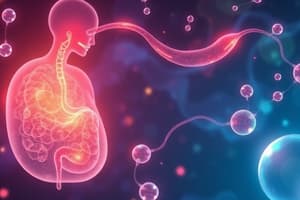Podcast
Questions and Answers
Which of these are digestible nutrients?
Which of these are digestible nutrients?
- Fats (correct)
- Nucleic acids (correct)
- Proteins (correct)
- Cellulose
Humans can digest cellulose.
Humans can digest cellulose.
False (B)
What is the main digestive enzyme for carbohydrates produced by the pancreas?
What is the main digestive enzyme for carbohydrates produced by the pancreas?
Pancreatic Amylase
Glycosidase enzymes exhibit some specificity for the __________ bond.
Glycosidase enzymes exhibit some specificity for the __________ bond.
What is the primary function of lactase?
What is the primary function of lactase?
What happens to carbohydrates that remain undigested in the GI tract?
What happens to carbohydrates that remain undigested in the GI tract?
Match the carbohydrate with its relevant characteristic:
Match the carbohydrate with its relevant characteristic:
Adult lactase levels are generally higher than infant levels.
Adult lactase levels are generally higher than infant levels.
Flashcards are hidden until you start studying
Study Notes
Nutrient Types
- Digestible nutrients include proteins, carbohydrates, fats (lipids), and nucleic acids.
- Indigestible nutrients, primarily fibers, lack necessary enzymes for digestion in humans (e.g., cellulose, pectin).
Digestion, Absorption, and Transport of Carbohydrates
- Carbohydrates are absorbed only if they can be broken down by specific enzymes; undigested carbohydrates remain unabsorbed.
- Key carbohydrates: starch, lactose, and sucrose.
- Begins with polysaccharides broken down into dextrins by salivary and pancreatic amylase, followed by disaccharidases (like maltase) converting them into monosaccharides for absorption.
Dietary Carbohydrates
- Contribute 40-45% of caloric intake in the USA, with 50-60% primarily from starch.
- Animal-derived carbohydrates include lactose from dairy products.
- Sucrose and small amounts of glucose and fructose serve as primary natural sweeteners in fruits, honey, and vegetables.
Monosaccharide Inter-conversion
- Glucogenic amino acids convert to glucose, generating pyruvate, which can be transformed into glucose via gluconeogenesis.
Digestion of Dietary Carbohydrates
- Glycosidases show specificity for the glycosidic bond and the number of residues in carbohydrates.
- Undigested carbohydrates ferment in the gut, potentially leading to increased fecal water content, contributing to diarrhea, especially after food poisoning or intestinal injury.
Salivary and Pancreatic Amylase
- Breaks down starch into maltose, isomaltose, limit dextrins, and trisaccharides, each needing specific enzymes for further breakdown.
- Daily production: 1 L of saliva and 1.5 L of pancreatic juice.
Disaccharidases of the Intestinal Brush-Border Membrane
- Enzymes work on various substrates through complexes:
- Maltase-Glucoamylase: Exoglucosidase targeting α–1,4 bonds.
- Sucrase-Isomaltase Complex: Similar to glucoamylase, acts on disaccharides.
- Trehalase: Specific for α-1,1 bonds in trehalose; notable for trehalase deficiency leading to health issues after mushroom consumption.
- Lactase-Glucosylceramidase Complex: Breaks down lactose; significant lactose intolerance prevalence (25% in Jordan).
Intestinal Locations of Activity
- Pancreatic amylase produces maltose and limit dextrins primarily in the duodenum.
- Sucrase–isomaltase and β-Glycosidase are most active in the jejunum, while glucoamylase activity peaks in the ileum.
Metabolism of Sugars by Colonic Bacteria
- Starches high in amylose or poorly hydrated are resistant to digestion and enter the colon.
- Dietary fibers and undigested sugars also reach the colon, where they are fermented by gut bacteria.
Indigestible Carbohydrates
- Humans lack enzymes to break down certain carbohydrates, contributing to lactose intolerance:
- Low lactase levels in adults compared to infants (less than 10%).
- Lactase persistence allows some adults to maintain higher lactase levels beyond infancy.
Studying That Suits You
Use AI to generate personalized quizzes and flashcards to suit your learning preferences.




